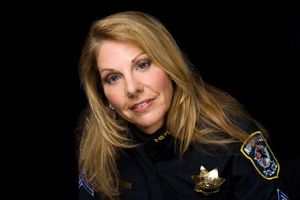Police1 columnist Betsy Brantner Smith has achieved many great things. As a 28-year veteran of the Naperville (Ill.) Police Department, Smith has held positions in patrol, investigations, narcotics, juvenile crime prevention, and field training. She has supervised her department’s K-9 Unit, served as a field training sergeant, recruitment team sergeant, bike patrol coordinator, and the Community Education/Crime Prevention Unit supervisor. She’s served as co-coordinator for NPD’s Citizen Police Academy and now serves on the Elderly Services Team, the Crisis Intervention Team, and is supervisory member of the department’s Honor Guard.
She’s been an instructor for the Calibre Press Street Survival Seminar since 2003 and is the creator and primary instructor for Street Survival for Women, the only internationally available officer survival seminar of its kind for female police officers.
She’s a mother of four, and wife to none other than J.D. “Buck” Savage (AKA PoliceOne’s very own Dave Smith). What more could she possibly add to a resume that extensive?
 Betsy Brantner Smith stars in Female Forces on the Biography Channel. The 13-episode “reality TV” series begins on Sunday, October 5th at 10PM (check your local listing). Watch the show and join the conversation by posting your comments below. (Photo courtesy of Betsy Brantner Smith) |
How about TV star?
Even though she’s gained widespread recognition in the police community as the host of Roll Call and LETN Live for the Law Enforcement Television Network and has appeared as the host of dozens of segments on P1TV, Smith now is entering the civilian entertainment spotlight as one of the stars of Female Forces, a new TV series that will debut this weekend on the Biography Channel.
As was reported in the Naperville Sun, the show chronicles five months in the lives of a dozen female officers of the Naperville Police Department. Included in the encounters by the officers of Female Forces in this 13-episode “reality TV” program are traffic stops, domestic disputes, DUIs, and various hot calls – the full gamut of what every officer in America might see on any given shift.
First and foremost, be safe!
The camera crew that followed her (and the other “characters” on the show) consisted of between five and seven people, frequently packed into both her own squad and a chase vehicle. Under those conditions, accounting for everybody’s safety becomes a challenge.
“I anticipated this issue and I did a Street Survival class for all the crew members. It was basically officer safety and survival for the television crew with a PowerPoint presentation and all that stuff. I talked to them about a lot of the stuff we talk about in the seminar. Just think, for example, about the guy who’s right next to me, filming me when I’m on a traffic stop. Where do you think he’s standing? He’s in the roadway! So I’m thinking, ‘Oh, this would not be good if my crew got run over or you know, were standing in the kill-zone.”
Smith also had to prevent the crew from interfering with her own safety or in the conduct of her work. Not surprisingly, she practiced what she and the other Calibre Press instructors preach. “First is to always be in the right condition – always be in the right color. I always make sure, and I made sure then, because the camera crew is very distracting, to always sit and do my pilot’s checklist and do my mental preparation. Am I in condition yellow? Am I ready to go? Am I in the right mindset?”
Smith says that another thing she does (with or without a gaggle of people in her wake carrying cameras, microphones, and other TV equipment), is to always anticipate situations and do her self-talk as she approaches every encounter.
“We’d be running to a hot call – and this was a positive thing about having the crew – I would explain to them: ‘We’re heading to a violent domestic. They’ve dispatched us because the guy just hit the wife with a table leg and there might be guns in the house and here’s how we’re going to approach it.’ So I would have to articulate to them everything that I was thinking and planning, and that’s actually a really good tactic to do. I was doing my self-talk out loud and by doing so I actually improved it.”
Why, exactly, are we even doing this?
The question at some point becomes, why would anyone add to everything else they’ve got going on in their squad car? Why would you add three other people, cameras, microphones, and all that other stuff to an already crammed cockpit?
Smith says that she had a few things in mind that she’d wanted to convey about her work as an officer to the (mostly civilian) viewers who will watch this program. Among those things was that she wanted the public to not just think ‘oh, it’s a cop’ when they see a squad drive by with a female officer behind the wheel.
“We want people to look and say, ‘Gosh, that’s somebody’s mom or that’s somebody’s daughter; that’s somebody’s wife or partner. She might be dealing with aging parents or she’s just another Scout-mom like me,’” Smith tells Police1. “You know, we want people to be able to look at us and say, ‘She’s just like me, she just happens to have a gun and a badge.’ Because you know, honestly, even though it’s 2008, people still stare at us when we’re walking down the street. Any woman cop will tell you that.”
Smith and the other female officers of Female Forces also wanted to show young women that police work is an appealing career choice. “It’s a cool job! You can still have a family, go to school, date, have fun, and do all the things that young – and old – women do. You know, you can take care of your family and have some fun, and still be a cop and still change people’s lives. So I think that was kind of our dual purpose,” Smith explains.
But Smith also says that the show has a great many things to say to her fellow officers. “Here’s the thing, it’s called Female Forces, but a lot of what you’re going to see is the relationships between men and women in the police department. There is a huge sense of family. We play pranks on each other and we joke around and yet we support each other and we fight when we’re mad at each other but there is this huge sense of family. I really want cops to tune in because they’re going to go: ‘Oh that’s just like my place! Oh, we do that! Oh, my Sergeant just said that to me! Oh, I’ve got a girl that works on my shift and she’s just like that!’ I think they’ll feel a kinship toward us.”
Smith also wants officers to tune in because in so doing, they’ll get an even greater appreciation for the different women in their own departments. “We just tend to go ‘Oh, well, what do the women think?’ and we tend to just lump ‘em all together. But women are all really different. We don’t all think alike, we don’t all look alike. That’s one of the things you’ll see in Female Forces – you’re going to see some really different women.”
Smith tells Police1 that this is especially great because most police departments in America number at around 20 officers or fewer, and consequently, many departments have just have one, maybe two female officers.
Trust who? The media? You’re kidding, right?
Smith says that although it was a little nerve-racking at first, from an officer safety perspective, to go from working alone or with one or two other people to having a stack of civilians in tow, she credits the crew with getting smarter as the filming went along. She said in the aforementioned Naperville Sun article that as they worked together through the months, the crew got better at knowing when not to follow along. And despite the tendency for police to have a natural (and well-reasoned) media-aversion, the Forces crew quickly gained her respect because they put themselves out there. They wore BAE Systems Second Chance armor, but none had formal police training, and for the most part, these people do their jobs without a lot of protection.
“You know, we cops are pretty shy when it comes to the media…generally speaking, when you bring a full camera crew into a police department, what do you think cops do? They walk the other way; they disappear. But these guys weren’t really media per se – the people on our crew have done everything from COPS to Survivor to you-name-it. And they weren’t there to make us look bad, they were there to make us (and the show) look good, so that gave us some level of comfort.”
Smith says that through it all, she tried to make sure that no matter what they were doing, no matter how hard things got, she made sure she and the crew had some fun every day. “We had some really tough, bad days. You know, where we were butt-deep in snow or we had suicides or had terrible things happen to people. I always made sure that me and the crew had at least one thing that we could laugh about every day, before the end of the day. And a lot of times it was at the end of the day, but we never went a day without it.”
Female Forces airs on the Biography Channel on Sunday, October 5th at 10PM Eastern and Pacific (check your local listing, etc). Watch the show and join the conversation by posting your comments below.


